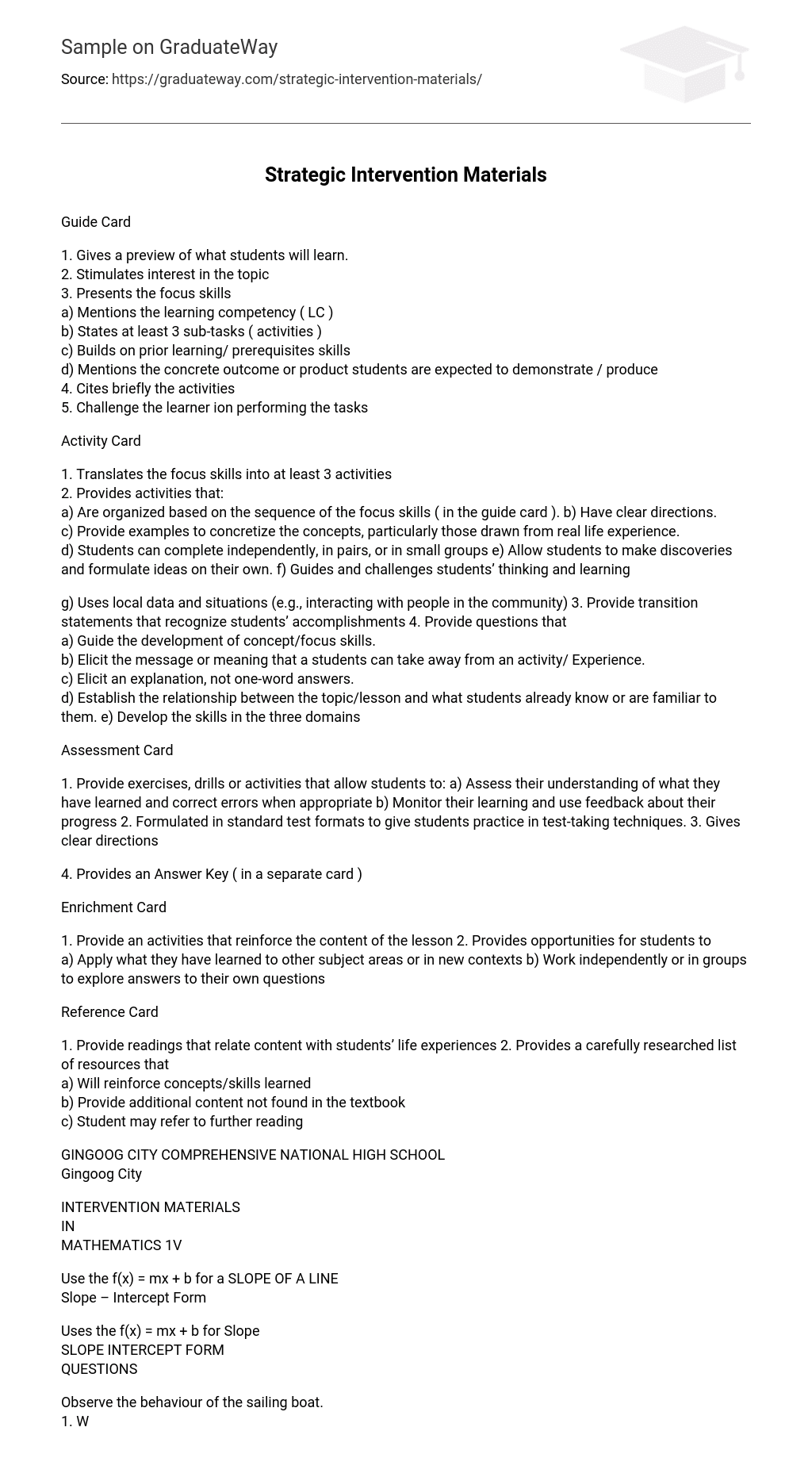Guide Card
1. Gives a preview of what students will learn.
2. Stimulates interest in the topic
3. Presents the focus skills
a) Mentions the learning competency ( LC )
b) States at least 3 sub-tasks ( activities )
c) Builds on prior learning/ prerequisites skills
d) Mentions the concrete outcome or product students are expected to demonstrate / produce
4. Cites briefly the activities
5. Challenge the learner ion performing the tasks
Activity Card
1. Translates the focus skills into at least 3 activities
2. Provides activities that:
a) Are organized based on the sequence of the focus skills ( in the guide card ). b) Have clear directions.
c) Provide examples to concretize the concepts, particularly those drawn from real life experience.
d) Students can complete independently, in pairs, or in small groups e) Allow students to make discoveries and formulate ideas on their own. f) Guides and challenges students’ thinking and learning
g) Uses local data and situations (e.g., interacting with people in the community) 3. Provide transition statements that recognize students’ accomplishments 4. Provide questions that
a) Guide the development of concept/focus skills.
b) Elicit the message or meaning that a students can take away from an activity/ Experience.
c) Elicit an explanation, not one-word answers.
d) Establish the relationship between the topic/lesson and what students already know or are familiar to them. e) Develop the skills in the three domains
Assessment Card
1. Provide exercises, drills or activities that allow students to: a) Assess their understanding of what they have learned and correct errors when appropriate b) Monitor their learning and use feedback about their progress 2. Formulated in standard test formats to give students practice in test-taking techniques. 3. Gives clear directions
4. Provides an Answer Key ( in a separate card )
Enrichment Card
1. Provide an activities that reinforce the content of the lesson 2. Provides opportunities for students to
a) Apply what they have learned to other subject areas or in new contexts b) Work independently or in groups to explore answers to their own questions
Reference Card
1. Provide readings that relate content with students’ life experiences 2. Provides a carefully researched list of resources that
a) Will reinforce concepts/skills learned
b) Provide additional content not found in the textbook
c) Student may refer to further reading
GINGOOG CITY COMPREHENSIVE NATIONAL HIGH SCHOOL
Gingoog City
INTERVENTION MATERIALS
IN
MATHEMATICS 1V
Use the f(x) = mx + b for a SLOPE OF A LINE
Slope – Intercept Form
Uses the f(x) = mx + b for Slope
SLOPE INTERCEPT FORM
QUESTIONS
Observe the behaviour of the sailing boat.
1. What have you notice to the behaviour of the sailing boat? 2. Tell something about the movement of the sailing boat.
3. Is the sailing boat travels smoothly? Why?
4. If you are the sailor of the said boat, how would you feel sailing in a) Fair weather?
b) Stormy weather?
5. Does the sail of the boat maintain a certain degree of stiffness? 6. Does the stiffness of the sail affect the velocity of the boat?
.This lesson will help you to obtain the slope and the y – intercept of a line from the general equation. You will reduce the general forms to the slope – intercept form by solving for y and the resulting coefficient of x is the slope and b, the y – intercept.
.To reduce the equation in standard form or general form, transform it to the slope – intercept form which is then called non – standard form and find the slope and y – intercept. 1. 6x – 8y + 16 =0
2. 4x + 2y = – 8
. What is the resulting slope – intercept form of the given equations? .What is its slope or m?
. What is its y – intercept or b?
.Transform the equations into slope – intercept form, and find the m and b of each equation. 3x + 4y = 10
2x + y = 5
Solve:
Given:
Point A( -1, -1 ), point B( 0, -2 ) and point C( 2,1 ).
1. Show that the three points are vertices of a Triangle.
2. Find the slope of each line.
3. What kind of triangle is formed?
4. Prove your answer.
.Functions serves as a meaningful way of applying mathematics to many real world situations and problems. They are efficient models of the relationships of two quantities that change with one another according to certain conditions. The ratio of the change in the dependent variable to the independent variable is called the slope of the line. .The general form r standard form of a linear function can be transform into a non-standard form, the Slope – Intercept Form or f(x) = mx + b. .Coronel, Antonio C. et. al. Advanced Algebra, with Trigonometry and Statistics. The Bookmark, Inc., 264 – A Pablo Ocampo Sr. Avenue, San Antonio Village, 1203 Makati City
Prepared by:
ELENA R. ORCALES
Math Teacher
Checked by:
ESTRELLITA M. MICUBO
Department Head – Mathematics





